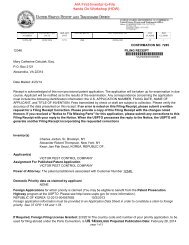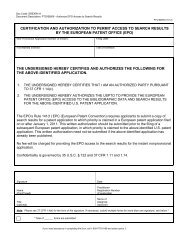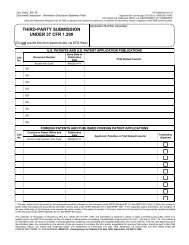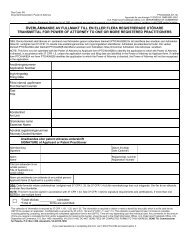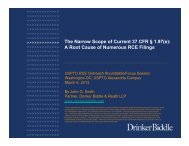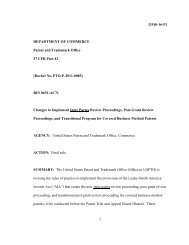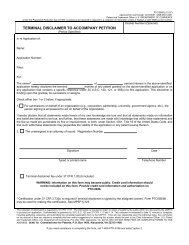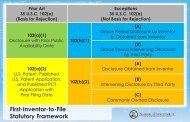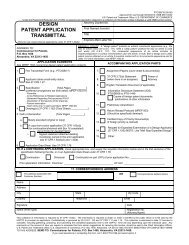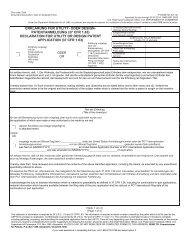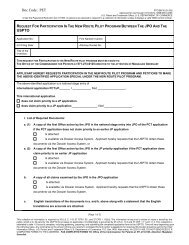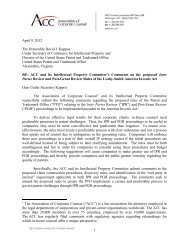USPTO Performance and Accountability Report - U.S. Patent and ...
USPTO Performance and Accountability Report - U.S. Patent and ...
USPTO Performance and Accountability Report - U.S. Patent and ...
Create successful ePaper yourself
Turn your PDF publications into a flip-book with our unique Google optimized e-Paper software.
OMB Financial Management Indicators<br />
The OMB prescribes the use of quantitative indicators<br />
to monitor improvements in financial management.<br />
The <strong>USPTO</strong> tracks other financial performance<br />
measures as well. The table above shows the <strong>USPTO</strong>’s<br />
performance during FY 2012 against performance<br />
targets established internally <strong>and</strong> by OMB <strong>and</strong> the<br />
government-wide Metric Tracking System (MTS).<br />
Prompt Payment Act<br />
The Prompt Payment Act requires Federal agencies<br />
to report on their efforts to make timely payments to<br />
vendors, including interest penalties for late<br />
payments. In FY 2012, the <strong>USPTO</strong> did not pay interest<br />
penalties on 99.4 percent of the 7,080 vendor<br />
invoices processed, representing payments of<br />
approximately $590.4 million. Of the 39 invoices that<br />
were not processed in a timely manner, the <strong>USPTO</strong><br />
was required to pay interest penalties on all<br />
39 invoices. The <strong>USPTO</strong> paid $7 in interest penalties<br />
for every million dollars disbursed in FY 2012.<br />
Virtually all recurring payments were processed by<br />
EFT in accordance with the EFT provisions of the Debt<br />
Collection Improvement Act of 1996.<br />
Civil Monetary Penalty Act<br />
Financial <strong>Performance</strong> Measure<br />
There were no Civil Monetary Penalties assessed by<br />
the <strong>USPTO</strong> during FY 2012.<br />
Debt Collection Improvement Act<br />
The Debt Collection Improvement Act prescribes<br />
st<strong>and</strong>ards for the administrative collection, compromise,<br />
suspension, <strong>and</strong> termination of Federal agency<br />
collection actions, <strong>and</strong> referral to the proper agency<br />
MANAGEMENT’S DISCUSSION AND ANALYSIS<br />
FY 2012<br />
Target<br />
for litigation. Although the Act has no material effect<br />
on the <strong>USPTO</strong> since it operates with minimal delinquent<br />
debt, all debt more than 180 days old has<br />
been transferred to the U.S. Department of the<br />
Treasury for cross-servicing.<br />
Biennial Review of Fees<br />
FY 2012<br />
<strong>Performance</strong><br />
Percentage of Timely Vendor Payments (MTS) 98% 99%<br />
Percentage of Payroll by Electronic Transfer (OMB) 90% 100%<br />
Percentage of Treasury Agency Locations Fully Reconciled (OMB) 95% 100%<br />
Timely <strong>Report</strong>s to Central Agencies (OMB) 95% 100%<br />
Audit Opinion on FY 2012 Financial Statements (OMB) Unqualified Unqualified<br />
Material Weaknesses <strong>Report</strong>ed by OIG (OMB) None None<br />
Timely Posting of Inter-Agency Charges (<strong>USPTO</strong>) 30 days 16 days<br />
Average Processing Time for Travel Payments (<strong>USPTO</strong>) 8 days 7 days<br />
The Chief Financial Officers Act of 1990 requires a<br />
biennial review of agency fees, rents, <strong>and</strong> other<br />
charges imposed for services <strong>and</strong> things of value it<br />
provides to specific beneficiaries as opposed to the<br />
American public in general. The objective of the<br />
review is to identify such activities <strong>and</strong> to begin<br />
charging fees, where permitted by law, <strong>and</strong> to periodically<br />
adjust existing fees to reflect current costs<br />
or market value so as to minimize general taxpayer<br />
subsidy of specialized services or things of value<br />
(such as rights or privileges) provided directly to<br />
identifiable non-Federal beneficiaries. The <strong>USPTO</strong> is<br />
a fully fee-funded agency without subsidy of general<br />
taxpayer revenue. The <strong>USPTO</strong> uses Activity Based<br />
Costing (ABC) to calculate the cost of activities<br />
performed for each fee, <strong>and</strong> uses this information to<br />
evaluate <strong>and</strong> inform when setting fees. When appropriate,<br />
fees are adjusted to be consistent with legislative<br />
requirements to recover full cost of the goods<br />
or services provided to the public as with the administrative<br />
trial proceedings established in the AIA.<br />
Consistent with the provisions of the AIA, the <strong>USPTO</strong><br />
expects to continuously assess fees, on at least a<br />
biennial basis after the initial fee adjustments anticipated<br />
for the Spring 2013. Section 10(c) of the AIA<br />
directs the <strong>USPTO</strong> to consult the PPAC <strong>and</strong> TPAC,<br />
respectively, annually on the advisability of reducing<br />
fees set or adjusted under Section 10(a).<br />
www.uspto.gov<br />
67


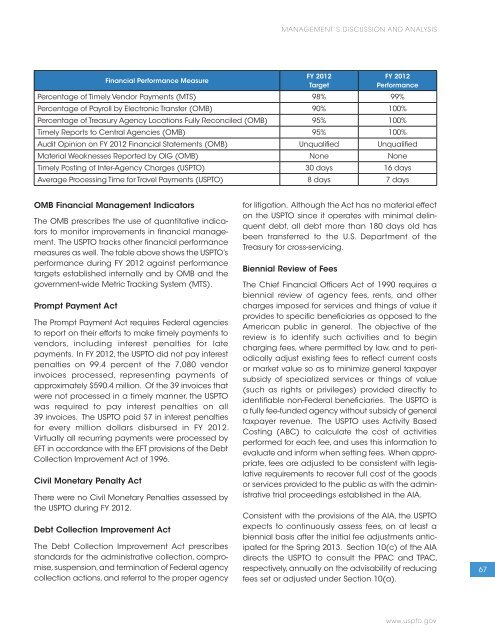
![Printable version [PDF] - United States Patent and Trademark Office](https://img.yumpu.com/51835259/1/184x260/printable-version-pdf-united-states-patent-and-trademark-office.jpg?quality=85)
